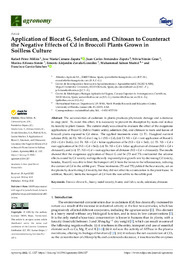Por favor, use este identificador para citar o enlazar este ítem:
https://hdl.handle.net/11000/33469Registro completo de metadatos
| Campo DC | Valor | Lengua/Idioma |
|---|---|---|
| dc.contributor.author | Pérez-Millán, Rafael | - |
| dc.contributor.author | Cámara-Zapata, José-María | - |
| dc.contributor.author | Fernández-Zapata, Juan Carlos | - |
| dc.contributor.author | Simon Grao, Silvia | - |
| dc.contributor.author | Alfosea Simón, Marina | - |
| dc.contributor.author | Shahid, Muhammad Adnan | - |
| dc.contributor.author | Garcia-Sanchez, Francisco | - |
| dc.contributor.other | Departamentos de la UMH::Física Aplicada | es_ES |
| dc.date.accessioned | 2024-10-11T11:10:45Z | - |
| dc.date.available | 2024-10-11T11:10:45Z | - |
| dc.date.created | 2022-05-30 | - |
| dc.identifier.citation | Agronomy 2022, 12(6) | es_ES |
| dc.identifier.issn | 2073-4395 | - |
| dc.identifier.uri | https://hdl.handle.net/11000/33469 | - |
| dc.description.abstract | The accumulation of cadmium in plants produces phytotoxic damage and a decrease in crop yield. To avoid this effect, it is necessary to prevent its absorption by roots and reduce its toxicity in plant tissues. The current study was aimed to evaluate the effect of the exogenous applications of Biocat G (fulvic/humic acids), selenium (Se), and chitosan to roots and leaves of broccoli plants exposed to Cd stress. The applied treatments were: (i) T1: Hoagland nutrient solution (NS), (ii) T2: NS + Cd at 3 mg L-1 (NS + Cd), (iii) T3: NS + Cd + root application of Biocat G (NS + Cd + BioG), (iv) T4: NS + Cd + foliar application of Se (NS + Cd + Se1), (v) T5: NS + Cd + root application of Se (NS + Cd + Se2), (vi) T6: NS + Cd + foliar application of chitosan (NS + Cd + chitosan1), and (vii) T7: NS + Cd + root application of chitosan (NS + Cd + chitosan2). The results showed that the exogenous application of Biocat G and Se (T3 and T5) ameliorated the adverse effects caused by Cd toxicity and significantly improved plant growth rate by decreasing Cd toxicity; besides, Biocat G was able to limit the transport of Cd from the leaves to the inflorescences, reducing the content of Cd in the edible part. These treatments (T3 and T5) yielded the best results, act on the plants by deactivating Cd toxicity, but they did not affect its accumulation in the plant tissue. In addition, Biocat G limits the transport of Cd from the non-edible to the edible part | es_ES |
| dc.format | application/pdf | es_ES |
| dc.format.extent | 14 | es_ES |
| dc.language.iso | eng | es_ES |
| dc.publisher | MDPI | es_ES |
| dc.rights | info:eu-repo/semantics/openAccess | es_ES |
| dc.rights | Attribution-NonCommercial-NoDerivatives 4.0 Internacional | * |
| dc.rights.uri | http://creativecommons.org/licenses/by-nc-nd/4.0/ | * |
| dc.subject | Brassica oleracea L. | es_ES |
| dc.subject | Heavy metal toxicity | es_ES |
| dc.subject | Humic and fulvic acids | es_ES |
| dc.subject | Selenium | es_ES |
| dc.subject | Chitosan | es_ES |
| dc.title | Application of Biocat G, Selenium, and Chitosan to Counteract the Negative Effects of Cd in Broccoli Plants Grown in Soilless Culture | es_ES |
| dc.type | info:eu-repo/semantics/article | es_ES |
| dc.relation.publisherversion | https://doi.org/10.3390/agronomy12061327 | es_ES |

Ver/Abrir:
Application of Biocat G, selenium, and chitosan to counteract the negative effects of Cd in broccoli plants.pdf
1,92 MB
Adobe PDF
Compartir:
 La licencia se describe como: Atribución-NonComercial-NoDerivada 4.0 Internacional.
La licencia se describe como: Atribución-NonComercial-NoDerivada 4.0 Internacional.
.png)